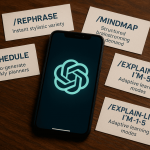The remarkable versatility of large-language models is tempered by a familiar pain point: occasional factual slips, shallow reasoning, or mismatched tone. Elevating ChatGPT from “generally helpful” to “mission-critical accurate” requires a blend of prompt craftsmanship, retrieval integration, model fine-tuning, and rigorous evaluation. This article dives deep into the techniques, settings, and safeguards that collectively sharpen the precision of your ChatGPT deployments.
Understand Where Errors Originate
Before tuning, profile the failure modes. Most inaccuracies stem from three sources: (1) knowledge gaps—the model’s training cutoff or sparse domain coverage; (2) prompt ambiguity—vague or multi-barreled queries; and (3) reasoning drift—the model’s tendency to hallucinate when confident but under-informed. Mapping these failure clusters guides targeted interventions instead of blanket fixes.
Craft Ultra-Clear System Instructions
Modern GPT APIs accept a system role that sets behavioral guard-rails. State explicit mandates such as “Answer concisely in academic English; cite each claim with a source; respond ‘insufficient data’ if unsure.” System messages outweigh user prompts and dramatically reduce stylistic or evidentiary drift, anchoring the model to your accuracy goals.
Layered Prompt Engineering
Single prompts are often inadequate for complex tasks. Adopt a layered pattern:
1) a setup prompt that defines context and constraints;
2) a task prompt that specifies the question;
3) an optional reflection prompt that asks the model to verify its own answer. For instance, “Draft the answer, then list three ways it might be wrong and revise.” This self-critique loop substantially cuts factual error rates.
Retrieval-Augmented Generation (RAG)
If knowledge currency matters (e.g., legal codes, product docs, research papers), integrate a search or vector-database step before calling ChatGPT. Retrieve the top-k relevant passages, embed them in the prompt, and instruct the model to quote or summarize only that evidence. RAG pipelines anchor generation to ground-truth sources, slashing hallucinations while preserving fluency.
Fine-Tune with Domain Data
For jargon-heavy or policy-sensitive domains, fine-tuning pays dividends. Prepare high-quality pairs of "prompt" and "completion" that exemplify correct, well-sourced answers. Keep prompts concise; pack completions with depth, citations, and the exact voice you expect. Two to five epochs on a few thousand exemplars often yield double-digit accuracy gains over the base model.
Leverage Parameter-Efficient Tuning (PEFT)
When GPU budget or privacy constraints prohibit full fine-tuning, apply adapters or LoRA layers. These lightweight techniques adjust only a tiny fraction of weights but still encode domain patterns. PEFT is ideal for on-device models or frequent iterative updates.
Dial-In Decoding Settings
Temperature and nucleus sampling (top_p) govern randomness. For accuracy-sensitive tasks, set temperature ≈ 0.1–0.3 and top_p ≈ 0.3–0.5. Lower values trade creativity for determinism, cutting speculative leaps. Use logit_bias to ban risky tokens (e.g., profanity) or boost required phrases (“According to”, “Source:”).
Chain-of-Thought with Hidden Scratchpads
Explicit reasoning improves correctness, but verbose chains can confuse end users. Instruct the model: “Think step-by-step internally, then provide a concise answer for the user.” Many APIs support scratchpad tokens or use the “delimiter trick” so the chain-of-thought is processed but not shown, combining rigor with readability.
Automatic Verification and Tool Use
Augment ChatGPT with external calculators, code interpreters, or fact-checking APIs. For quantitative answers, have the model output a JSON spec of required calculations; pass that to Python; feed the results back for narrative synthesis. This tool-augmented loop produces near-expert-level accuracy in domains like finance, engineering, and medicine.
Multistage Voting & Consensus
Run multiple model instances with slight prompt variations, then ensemble their outputs. A majority-vote or confidence-weighted merge often outperforms any single call. For high-stakes deployments, cascade to a second model trained to spot contradictions, yielding a robust consensus layer.
Human-in-the-Loop Evaluation
Automated metrics (BLEU, ROUGE, factuality classifiers) provide baseline signals, but domain experts should score random samples for correctness, completeness, and citation quality. Log failures, tag them by root cause, and feed back into either prompt adjustments or dataset expansions.
Continuous Monitoring and Drift Control
Accuracy degrades over time as real-world facts change. Implement monitoring dashboards: track answer error rates, user-flagged mistakes, and coverage of new terminology. Schedule retraining or RAG corpus refreshes monthly or when drift exceeds a pre-set threshold.
Governance and Safety Nets
Precision is worthless if the model violates privacy or ethical norms. Layer content filters, personally-identifiable-information detectors, and policy-based refusals before answers reach end users. Document every tuning run, dataset version, and evaluation score for auditability.
Conclusion
High-accuracy ChatGPT systems emerge from a tapestry of best practices: disciplined prompt design, evidence retrieval, smart decoding, targeted fine-tuning, and relentless evaluation. Treat these techniques not as isolated tricks but as mutually reinforcing stages in a production pipeline. The payoff is substantial—responses that are not only eloquent but verifiably correct, earning the trust of stakeholders and end users alike.



lol th tweak tips insane 😲
yes!! smarter ai 👍👍